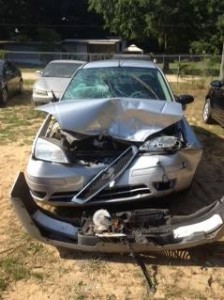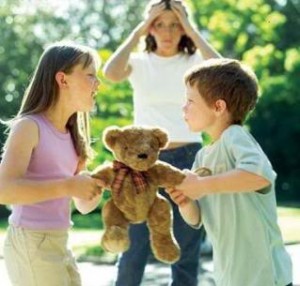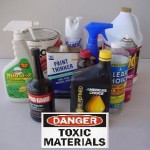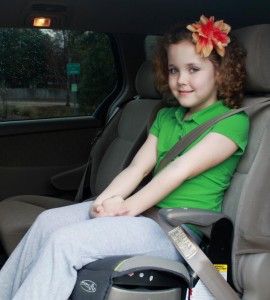by Ginny Hinton | Jun 5, 2013

The proper seat correctly installed helps keep children safe.
Dawson is a healthy, active 3-year-old whose mom makes sure he eats right, learns something new every day, and rides safely in the car. Until a few months ago, Dawson, who weighs 42 pounds and is 42 inches tall, traveled in a booster seat. When his mom learned that, because of his age, Dawson would be safer in a 5-point harness, she moved him to a safer car seat and made sure it was installed correctly. Just a few weeks ago, Dawson was riding in the car with relatives when someone drove in front of them and caused a 45 mph crash, totaling both cars. One of the adults fractured her collarbone; another suffered a concussion. Dawson bit his tongue and was really scared – but he was unhurt. Dawson’s mom says she is truly thankful she put him in the correct car seat. Because car seats are made to survive only one crash, she has already replaced his old seat and Dawson continues to travel safely in the car.
Dawson’s story can happen to any child. It’s important that every parent know how to keep their children safe on the roads. Here are some quick pointers to keep children safe at every age:
- All infants and toddlers should ride in a Rear-Facing Car Seat until they are 2 years old or until they reach the highest weight/height allowed by the manufacturer. Rear-facing is the safest way to travel!
- Children 2 years to at least 4 years old and 40 pounds should use a Forward-Facing Car Seat with a harness for as long as possible. Keeping a child who weighs more than 40 pounds in a harness is the safest practice, as long as the seat’s weight limits are followed.
- Children whose weight or height is above the forward-facing limit for their car seat should use a Belt-Positioning Booster Seat until the vehicle seat belt fits properly, typically when they are at least 4 feet 9 inches tall and are between 8 and 12 years old. Children using a booster seat should be able to sit reasonably still for an entire trip.
- Children who are old enough and large enough to use the vehicle seat belt alone should always use both Lap and Shoulder Belts for the best protection. Children younger than 13 years should sit in the back seat.
Certified Child Passenger Safety Technicians (CPSTs) are trained to help caregivers make sure their children are traveling safely. Find a CPST near you at http://cert.safekids.org.
by Monica Brinkley | Apr 23, 2013
Se lf-control is an important skill for all children to learn. In other words, individuals know right from wrong or have power to control their own actions. Self-control is the ability to think before you act, rather than being controlled by your feelings. Children who rely on parents or other children to make choices for them do not learn self-control.
lf-control is an important skill for all children to learn. In other words, individuals know right from wrong or have power to control their own actions. Self-control is the ability to think before you act, rather than being controlled by your feelings. Children who rely on parents or other children to make choices for them do not learn self-control.
Often times, these children may follow others’ bad choices and not take responsibility for the consequences of their behavior. When the child is young, this causes many frustrations. As they grow, the problems can grow as well and the consequences can become more and more serious, even leading to self-destructive behavior like the use of drugs and alcohol. Therefore, it is very important to start young to build the skills that children will need later in life.
Self-control lessons start in the first year of life, but it is never too late to help a child build more self-control. Research shows that when you respond predictably to an infant who cries, later on that baby is likely to cry less rather than more. So you need to get to know your baby’s style of soothing.
Toddlerhood is a demanding time for parent and child. Many toddlers become frustrated because they may have trouble making themselves understood or may be too little to do the things they want to do. Expect toddlers to have little self-control.
Children behave best by keeping them on a regular schedule as much as possible. Help them get enough rest and serve regular meals and snacks. At this age, children are very distractible – you can redirect them to another activity when they are doing something unsafe. If your child has a temper tantrum, make sure they are safe and keep them from hurting themselves or others. After the tantrum is over, they need comfort and support. Teach some basic words, such as NO and STOP, to use in difficult situations. The goal of self-control at this age is to help children begin to use words to express themselves.
During the preschool years, children are eager to play with others their own age, but it is rarely smooth. The goal of this stage of development is to learn how to talk about a problem and solve it with words rather than aggressions. Encourage children to say what the problem is and ask them to come up with ideas for a solution. As long as all the children involved agree, let them try out their own solutions.
This is the time to introduce family chores. Simple jobs like setting the table and putting away laundry are good for children at this age. Research has found that children who have regular chores from the age of four are more successful in early adulthood.
The work of helping your child build self-control continues through the elementary school years and into the teen years. Children learn to be responsible by handling homework, family chores, and obligations to friends and family. Starting early and carrying on self-control lessons throughout your child’s developing years is the best way to give the gift of healthy self-control.
by Dorothy C. Lee | Oct 24, 2012
 What you don’t know can hurt you. “I didn’t know.” In these words lies the story of countless deaths and injuries in countless homes.
What you don’t know can hurt you. “I didn’t know.” In these words lies the story of countless deaths and injuries in countless homes.
About one-half of the accidental deaths of children occur in the home— from falls, suffocation/choking, scalding, poisoning, and burning. Elderly persons, likewise, are subject to greater dangers because of infirmities and impaired faculties. Yet the concern about home accidents is not only for the very young or the very old. Accidents at home can strike people of all ages.
Every year, over two million poisonings are reported to Poison Control Centers across the country, and more than ninety percent of those happen in the home. The majority of non-fatal poisonings occur among children younger than six years, and poisoning is one of the leading causes of death among adults.
The medicine cabinet is a favorite attraction for curious young children. It is not enough to put poisons and certain types of medicines on high shelves because exploring children like to climb. Dangerous substances need to be locked up.
A significant number of children are being poisoned by consuming medicines brought into the home by grandparents or visitors. Poisonings also have occurred when youngsters have visited homes where no children live.
Substances which can cause accidental poisoning in children also are found outside the medicine cabinet. The list is a lengthy one—detergents, cleaning compounds, insect sprays, paint thinners, and antifreeze, just to name a few.
Children are not the only victims of accidental poisoning. Every year, there are numerous cases of men and women who poison themselves unintentionally. To help prevent a tragic accident in your home, follow safety-wise guidelines.
Keep household products separated. Take care that foods are not exposed and become contaminated when you use insect sprays, cleaning agents, and rodent poisons.
- Containers with flammable liquids should be clearly labeled.
- Flammable liquids such as gasoline should be stored in a cool, well-ventilated place, not inside the home.
- Never pour flammable liquids down sinks or other drains.
- Store medicines and cleaning supplies in locked cabinets out of children’s reach.
The Centers for Disease Control report that about 12,000 children every year are victims of poisonous plants or berries they have ingested, or in some cases, just put into their mouths. Most persons are reasonably familiar with dangerous outdoor plants, such as poison ivy, oleander, or deadly nightshade, but what they do not know is even some of the most common houseplants can cause serious, even fatal reactions. For example, tea brewed from mistletoe berries is lethal and rhubarb leaves (not the stalks) contain oxalic acid, which can cause severe kidney damage.
One home safety issue that is not well-publicized regards pressurized containers. Pressurized containers have revolutionized packaging economy, but caution is necessary in their use. Never incinerate a pressurized container. The heat will cause the air inside to expand, which, in turn, may cause the container to burst. Read the warning message on the container to find out if the mixture is flammable. Keep pressurized containers away from children.
Keeping home safety in mind at all times can mean the difference between a happy home environment and a tragedy.
Note: See the following article for additional information on home safety and children, http://www.nanny.net/blog/9-most-common-household-poisons/
by Ginny Hinton | Jul 6, 2012

A booster seat “boosts” a child up for proper placement of the lap and shoulder belt on the lower hips/upper thighs and shoulder/collar bone.
Piper is 7 years old. She goes to school, plays with dolls, and loves to visit friends. Piper’s career goal is to take over the world through “flower power”. When Piper travels, she sits in a booster seat that makes her seat belt fit perfectly. In a crash, Piper’s seat belt will keep her in the car and distribute crash forces across the strongest parts of her body. Piper’s mom makes sure she travels safely on every trip, so that Piper can confidently pursue her plans for world dominion.
Unfortunately, Piper and her mom are the exception. Many children in elementary school need to sit in booster seats but don’t. Following the law is not enough, especially for children in Florida. Only in Florida can a 4-year-old child legally use an adult seat belt.
In a crash, poor seat belt fit can lead to serious internal injury or even death. Children who have outgrown their 5 point harness car seat by weight or height should use a booster seat until they reach approximately 4’9”, typically between the ages of 8-12. Many parents/caregivers skip this very important step and start using a seat belt much too soon, never realizing the danger in which they’re putting their child.
A booster seat “boosts” a child up for proper placement of the lap and shoulder belt on the lower hips/upper thighs and shoulder/collar bone. Without a booster, seat belts often cross over a child’s soft stomach and neck, which can lead to debilitating injuries such as a ruptured spleen, torn intestines, internal bleeding, or paralysis.
Booster seats keep children out of the hospital, saving heartache, worry and medical expenses. A $15 booster seat for a child age 4-7 yields an average savings of $2,500 per child. “Big kids” like Piper deserve to be kept safe when they travel, and booster seats help make that happen. Is your child riding safely in the car?
For more information or assistance with child passenger safety please contact Ginny Hinton at the Santa Rosa County UF/IFAS Extension Office: ginnyh@santarosa.fl.gov or 850-623-3868.
(NHTSA & Partners for Child Passenger Safety (PCPS), **(Pacific Institute for Research and Evaluation (2010 update, ‘Injury Prevention: What works?’ Special Thanks to Tamyne Maxson, Child Passenger Safety Community Coordinator, St. Joseph’s Child Advocacy Center, Tampa, FL
by Angela Hinkle | Jun 1, 2012
School’s out! One way to get creative with all this extra time and to eat nutritiously is to make and eat healthy snacks. Like an arts and crafts project, making a snack can be a great summertime activity. Bonus: the kids get to eat their artwork and you get to sneak nutritious foods into their day for a healthy diet.
Some works of art need the following elements:
- Foundation – slices of whole wheat bread, tortillas, English muffins, lettuce leaves, rice cakes, zucchini or cucumber rounds, apple or pineapple slices.
- Glue – peanut butter, low-fat cream cheese, cheese spread, hummus, refried beans, low-fat yogurt, jam, pizza sauce, or low-fat ranch dressing.
- Bling – seeds, nuts, grapes, raisins, match stick carrots, olives, beans, low-fat granola, diced fruits and veggies.
Start from the foundation and work up to the bling. Create faces, animals, or landscapes. Let the plate be your canvas. It’s a great way to try a new food or sample a food prepared in a totally different way.
For other works of art, use toothpicks, skewers, popsicle sticks, or edible pretzel rods to make shish kabobs. Cut out cheese shapes with small cookie cutters and add to the stick alternating with cut-up fruits and vegetables. Make a beautiful edible bouquet.
Kids also are more likely to enjoy new foods if they are served in fun containers. Try using mugs, champagne glasses, ice cream cones, or party hats.
Be sure to include nutritious foods from all the food groups as your artists create throughout the summer: load up on fruits and vegetables, incorporate whole grains, and go lean on the dairy and protein.
No sitting around loading up on unhealthy “junk” foods out of boredom this summer. The time for healthy edible snack art is now.





